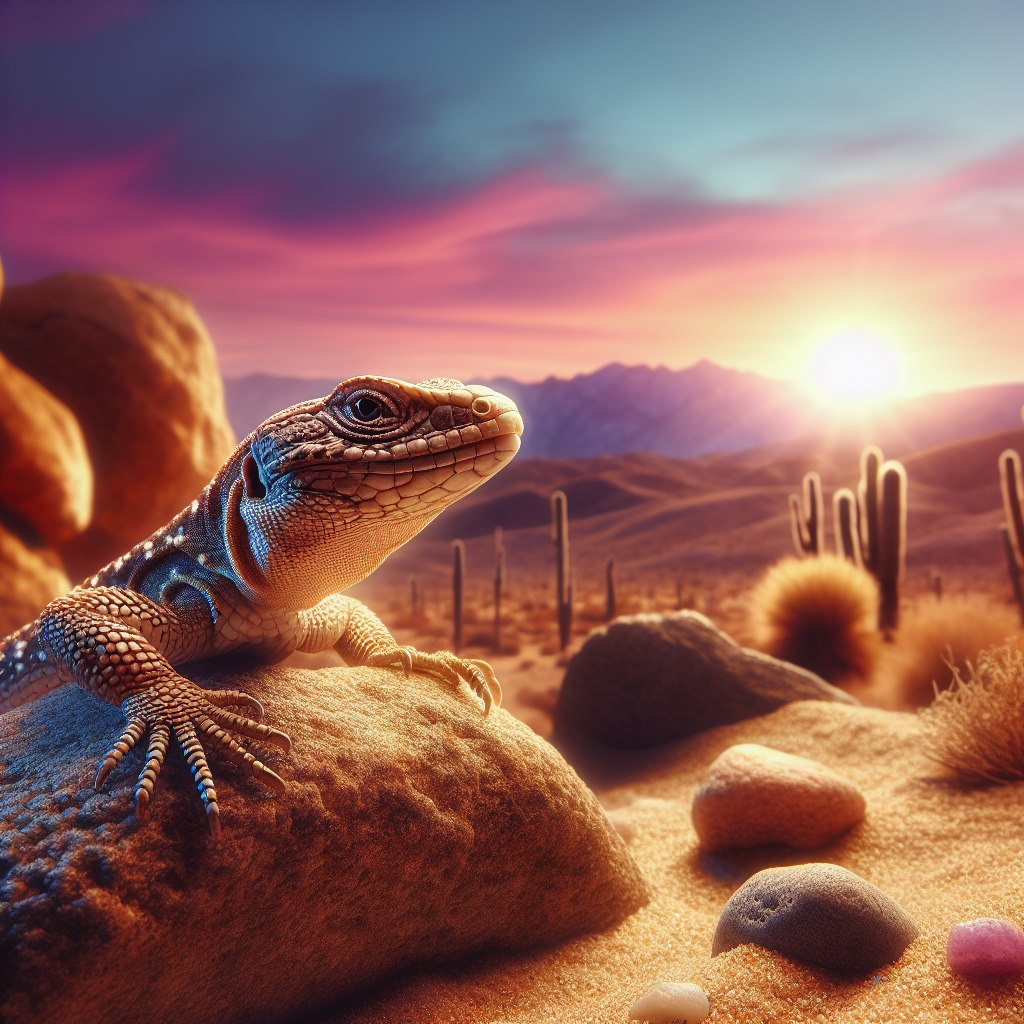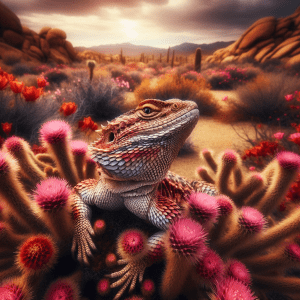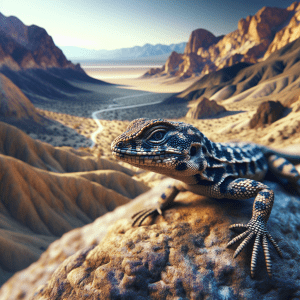Introduction to Mojave Desert Lizard Citizens
Have you ever stopped to think about the diverse community of lizards that call the Mojave Desert their home? It’s truly fascinating how these little reptiles have adapted to thrive in such a harsh environment.
Just the other day, I was hiking in the Mojave Desert and came across a beautiful lizard basking in the sun. It was a surreal moment, watching it blend seamlessly into its surroundings, showcasing the incredible camouflage skills that Mojave Desert lizards possess.
Did you know that Mojave Desert lizards have a unique way of regulating their body temperature? They often engage in “shuttling behavior,” where they move between sun and shade to maintain their ideal body temperature. It’s like they have their own built-in thermostat!
Observing these lizard citizens in their natural habitat made me appreciate the delicate balance of the desert ecosystem even more. They play a crucial role in controlling insect populations and are essential to the overall biodiversity of the region.
But here’s a thought-provoking question for you: How can we ensure the continued survival of Mojave Desert lizards in the face of environmental challenges and habitat destruction? Conservation efforts are crucial to protect these fascinating creatures for future generations to enjoy.
As we delve deeper into the world of Mojave Desert lizard citizens, we’ll uncover their secrets, learn about their behaviors, and explore the interconnected web of life in the desert. So, join me on this journey of discovery as we appreciate and protect these remarkable inhabitants of the Mojave Desert.
Types of Lizards in the Mojave Desert
Have you ever wondered about the diverse types of lizards that call the Mojave Desert their home? It’s truly a sight to behold! From the sleek and speedy Greater Earless Lizard to the charismatic Desert Iguana, these reptilian residents bring the desert landscape to life in their own unique ways.
Let me share an interesting fact with you – did you know that the Mojave Fringe-toed Lizard has specialized scales on its toes that help it move swiftly across loose sand dunes? It’s like having built-in snowshoes but for the desert! These adaptations are essential for their survival in the harsh desert environment.
Each type of lizard in the Mojave Desert has its own story to tell. Whether it’s the spiny tail of the Zebra-tailed Lizard or the vibrant colors of the Collared Lizard, there’s a treasure trove of biodiversity waiting to be discovered. These lizards play a crucial role in maintaining the delicate balance of the desert ecosystem, from controlling insect populations to serving as a food source for predators.
As we delve deeper into the world of Mojave Desert lizards, we uncover not just fascinating facts but also a deeper appreciation for the interconnectedness of all living beings. Observing these creatures in their natural habitat can be a rewarding experience, but it also comes with a responsibility to ensure their continued existence for future generations to enjoy.
So, the next time you find yourself in the Mojave Desert, take a moment to appreciate the beauty and resilience of these lizard citizens. They may be small in size, but their presence looms large in the vast expanse of the desert landscape. Let’s celebrate these remarkable creatures and the vital role they play in the intricate tapestry of desert life.
Unique Characteristics of Mojave Desert Lizards
Have you ever noticed how Mojave Desert lizards possess some truly unique characteristics that set them apart from other reptiles? It’s pretty fascinating stuff! From their specialized diets to their remarkable camouflage abilities, Mojave Desert lizards are truly remarkable creatures.
Let’s delve into some of these distinctive characteristics. One interesting fact about Mojave Desert lizards is their ability to blend seamlessly into their surroundings. These clever critters have evolved to match the colors and patterns of the desert landscape, making them almost invisible to predators and unsuspecting prey. It’s like they have their own built-in invisibility cloak!
Another cool feature of Mojave Desert lizards is their ability to regulate their body temperature. These cold-blooded creatures rely on basking in the sun to warm up and seek shade to cool down. It’s like they have their own internal thermostat, adjusting to the desert’s extreme temperatures with ease.
Now, here’s where it gets even more captivating. Mojave Desert lizards have developed specialized adaptations to survive in their harsh environment. Some species have evolved to have water-efficient kidneys, allowing them to thrive in arid conditions with limited water sources. It’s like they’ve cracked the code on desert living!
As we explore these unique characteristics of Mojave Desert lizards, it’s incredible to think about how these adaptations have enabled them to thrive in one of the harshest environments on Earth. Their resilience and ingenuity in the face of challenges remind us of the incredible diversity and adaptability of the natural world.
Next time you’re out in the Mojave Desert, keep an eye out for these fascinating lizard citizens and marvel at the remarkable ways they have evolved to call this arid landscape home. Who knows, you might just spot one of these incredible creatures showcasing their extraordinary characteristics right before your eyes!
Role of Lizards in the Desert Ecosystem
When it comes to the Mojave Desert, you can’t overlook the vital role that lizards play in the ecosystem. These little creatures may seem insignificant at first glance, but trust me, they are essential for maintaining the delicate balance of nature in this harsh environment.
Imagine a scorching hot day in the Mojave Desert, with the sun beating down relentlessly. As you look around, you’ll notice these resilient lizards scurrying about, seemingly unfazed by the extreme conditions. These creatures have adapted remarkably well to the harsh desert environment, and their presence is crucial for the ecosystem’s health.
One interesting fact about Mojave Desert lizards is that they are skilled predators, feeding on insects and other small creatures. By keeping the insect population in check, these lizards help maintain the balance of the desert ecosystem. Without them, the delicate equilibrium could be disrupted, leading to unforeseen consequences for other species in the area.
Now, let’s dive into the role of lizards in the desert ecosystem. These reptiles act as both predator and prey, forming a crucial link in the food chain. By feeding on insects and being a food source for larger predators, such as birds of prey, lizards help maintain the biodiversity of the Mojave Desert.
Their presence also contributes to seed dispersal and soil aeration, further highlighting their importance in the ecosystem. By burrowing into the ground, lizards create small tunnels that improve soil structure and help with water absorption, benefiting other plant species in the desert.
So, next time you spot a Mojave Desert lizard basking in the sun, take a moment to appreciate the valuable role they play in this unique and challenging environment. These seemingly unassuming creatures are true desert citizens, essential for the Mojave Desert’s health and vitality.
Conservation Efforts for Mojave Desert Lizards
Let me tell you about the conservation efforts for Mojave Desert lizards. It’s fascinating how people are working together to protect these unique creatures. Did you know that the Mojave Desert is home to several species of lizards, each playing a vital role in the desert ecosystem?
Conservation efforts for Mojave Desert lizards are crucial because these reptiles face many threats to their survival. One interesting fact is that habitat loss due to urban development and climate change poses a significant challenge to their populations. It’s sad to think about these amazing creatures losing their homes.
To help protect Mojave Desert lizards, conservationists are focusing on creating protected areas and implementing sustainable land management practices. These efforts not only benefit the lizards but also contribute to the overall health of the desert ecosystem. Imagine a world where these majestic lizards roam freely without the fear of losing their habitat.
One practical tip for those interested in supporting Mojave Desert lizard conservation is to educate others about the importance of preserving their natural habitat. By spreading awareness and advocating for conservation efforts, we can all play a part in ensuring the survival of these incredible creatures.
So, next time you’re exploring the Mojave Desert, take a moment to appreciate the beauty of these lizard citizens and consider what you can do to help protect them. Let’s work together to ensure that future generations can continue to marvel at the wonders of Mojave Desert lizards.
Best Practices for Observing Lizards in their Natural Habitat
Imagine we’re out in the Mojave Desert, surrounded by the vast expanse of sand and rocks, and suddenly, we spot a lizard basking in the sun. It’s a magical moment to witness these fascinating creatures in their natural habitat. So, how can we make the most of this experience and observe Mojave Desert lizards without disturbing them?
One practical tip for observing lizards in their natural habitat is to approach them slowly and quietly. Lizards are sensitive to sudden movements and loud noises, so maintaining a calm demeanor is essential to avoid startling them. By moving slowly and patiently, we increase our chances of getting a closer look at these elusive creatures without causing them distress.
Another important aspect to consider is the time of day. Mojave Desert lizards are most active during the early morning and late afternoon when the temperatures are more moderate. So, if we want to catch a glimpse of these reptiles in action, heading out during these times can increase our chances of spotting them engaging in their natural behaviors, such as hunting for food or basking in the sun.
When observing Mojave Desert lizards, it’s crucial to respect their space and avoid interfering with their activities. Remember, we are guests in their home, and it’s our responsibility to observe them from a safe distance without disrupting their natural behavior. By being mindful of our actions and practicing responsible wildlife viewing, we can enjoy the beauty of these desert-dwelling creatures while ensuring their well-being.
So, next time you find yourself in the Mojave Desert, keep these tips in mind as you embark on a lizard-spotting adventure. By approaching with care and consideration, you can witness the wonder of Mojave Desert lizard citizens in their element and gain a deeper appreciation for the delicate balance of nature.
Threats to Mojave Desert Lizard Populations
Let me tell you about the threats facing Mojave Desert lizards. Did you know that these fascinating creatures are facing challenges that are putting their populations at risk? One significant threat comes from habitat loss due to human activities such as urbanization and infrastructure development. As more land is cleared for expanding human settlements and industries, the natural habitats of Mojave Desert lizards are shrinking rapidly.
Another major concern is the impact of climate change on these lizard populations. Rising temperatures and changes in precipitation patterns can disrupt the delicate balance of their ecosystem, affecting their food sources and breeding habitats. Mojave Desert lizards are adapted to thrive in specific environmental conditions, and any drastic alterations can have detrimental effects on their survival.
In addition to these environmental threats, Mojave Desert lizards also face risks from predation by invasive species and illegal collection for the exotic pet trade. These factors, combined with pollution and disease outbreaks, pose significant challenges to the long-term viability of Mojave Desert lizard populations.
As we delve into these issues, it’s essential to recognize the interconnectedness of all living beings in the desert ecosystem. The decline of Mojave Desert lizards could have cascading effects on other species and the overall health of the desert environment. By understanding and addressing these threats, we can work towards ensuring the conservation and protection of these unique lizard citizens for future generations to appreciate and enjoy.
It’s crucial for us to raise awareness about the threats facing Mojave Desert lizards and take action to mitigate these risks. Through conservation efforts, habitat restoration, and responsible environmental practices, we can help safeguard the habitats and well-being of these remarkable creatures. Let’s make a difference and ensure that Mojave Desert lizards continue to thrive in their natural environment.
Interesting Facts about Mojave Desert Lizards
You know, when it comes to Mojave Desert lizards, there are some truly fascinating facts that most people don’t know about. For instance, did you know that some species of Mojave Desert lizards can detach their tails as a defense mechanism? It’s like a superhero power, but for survival in the wild!
Imagine encountering a lizard in the desert, and suddenly, poof! Its tail pops off and continues to wiggle around, distracting predators while the lizard makes a quick getaway. It’s both impressive and a bit bizarre, don’t you think?
This unique ability of lizard species in the Mojave Desert is not just a cool party trick; it serves a crucial purpose in their survival strategy. By sacrificing their tails when under threat, these lizards increase their chances of escaping unharmed and living to see another day.
Now, the question arises – how does the tail actually detach? Well, it’s all about a special fracture plane in their tail vertebrae that allows for a quick release. The tail will continue to move for a short while, drawing attention away from the lizard’s body and giving it a chance to flee to safety.
But here’s where it gets even more interesting. The lizard doesn’t just lose its tail permanently; it has the remarkable ability to regenerate a new one! Within a few weeks, a new tail starts to grow, although it may not look exactly the same as the original. This regeneration process is a marvel of nature and showcases the incredible adaptability of these desert-dwelling creatures.
So, the next time you spot a Mojave Desert lizard and marvel at its unique features, remember the extraordinary defense mechanism it possesses. It’s a reminder of the ingenuity and resilience of these reptilian residents in the harsh desert environment.
Tips for Photographing Mojave Desert Lizards
Have you ever tried to capture the perfect photograph of a Mojave Desert lizard? It can be quite the adventure! These elusive creatures are quick on their feet and often blend seamlessly into their desert surroundings, making them a challenging subject to photograph.
I remember the first time I attempted to photograph a Mojave Desert lizard. I was crouched down, camera in hand, waiting patiently for one to emerge from its hiding spot among the rocks. Just as I thought I had the perfect shot lined up, the lizard darted away in a flash, leaving me with nothing but a blur in my frame. It was a lesson in patience and quick reflexes, that’s for sure!
One practical tip I’ve picked up along the way is to observe the lizards from a distance before attempting to get closer for a photograph. By watching their behavior and movements, you can better anticipate their next steps and position yourself for the best shot. Additionally, using a telephoto lens can help you capture detailed images without disturbing the lizards in their natural habitat.
Photographing Mojave Desert lizards not only requires technical skill but also a deep appreciation for these fascinating reptiles. As you strive to capture their beauty through your lens, take a moment to consider the broader significance of your images. Your photographs can serve as a testament to the unique wildlife that calls the Mojave Desert home, raising awareness about the importance of conservation efforts to protect these lizard citizens.
So, next time you find yourself in the Mojave Desert with camera in hand, keep these tips in mind as you embark on your lizard photography adventure. Who knows, you might just capture that perfect shot that tells the story of these remarkable desert dwellers!
Appreciating and Protecting Mojave Desert Lizard Citizens
Mojave Desert lizards are truly fascinating creatures, and I recently learned a mind-boggling fact about them that I just have to share with you. Did you know that some Mojave Desert lizards have the ability to detach their tails when threatened by predators? It’s a defense mechanism known as “autotomy,” and it allows the lizard to escape while the predator is left distracted by the wriggling tail. Isn’t nature just incredible?
This ability to detach their tails serves as a crucial survival strategy for Mojave Desert lizards, but it also raises some interesting questions about the trade-offs they make in the face of danger. Imagine the lizard’s perspective – sacrificing a part of itself to ensure its overall survival. It’s a fascinating glimpse into the intricate balance of nature and the extraordinary adaptations that have evolved over time.
So, when observing Mojave Desert lizards in their natural habitat, it’s essential to respect their space and understand the behaviors that help them thrive in such harsh environments. If you ever encounter one of these amazing creatures, remember to observe from a distance and appreciate the unique adaptations that make them such resilient residents of the desert.
While it may seem like a small detail, the ability of Mojave Desert lizards to detach their tails is a powerful reminder of the incredible diversity and complexity of the natural world. It’s a testament to the ingenuity of evolution and the endless wonders waiting to be discovered in the Mojave Desert and beyond. Next time you come across a Mojave Desert lizard, take a moment to marvel at the remarkable adaptations that make them true survivors in their harsh desert home.




